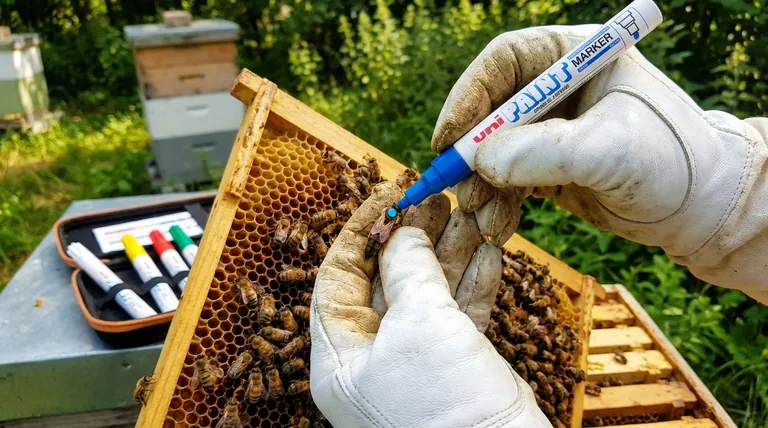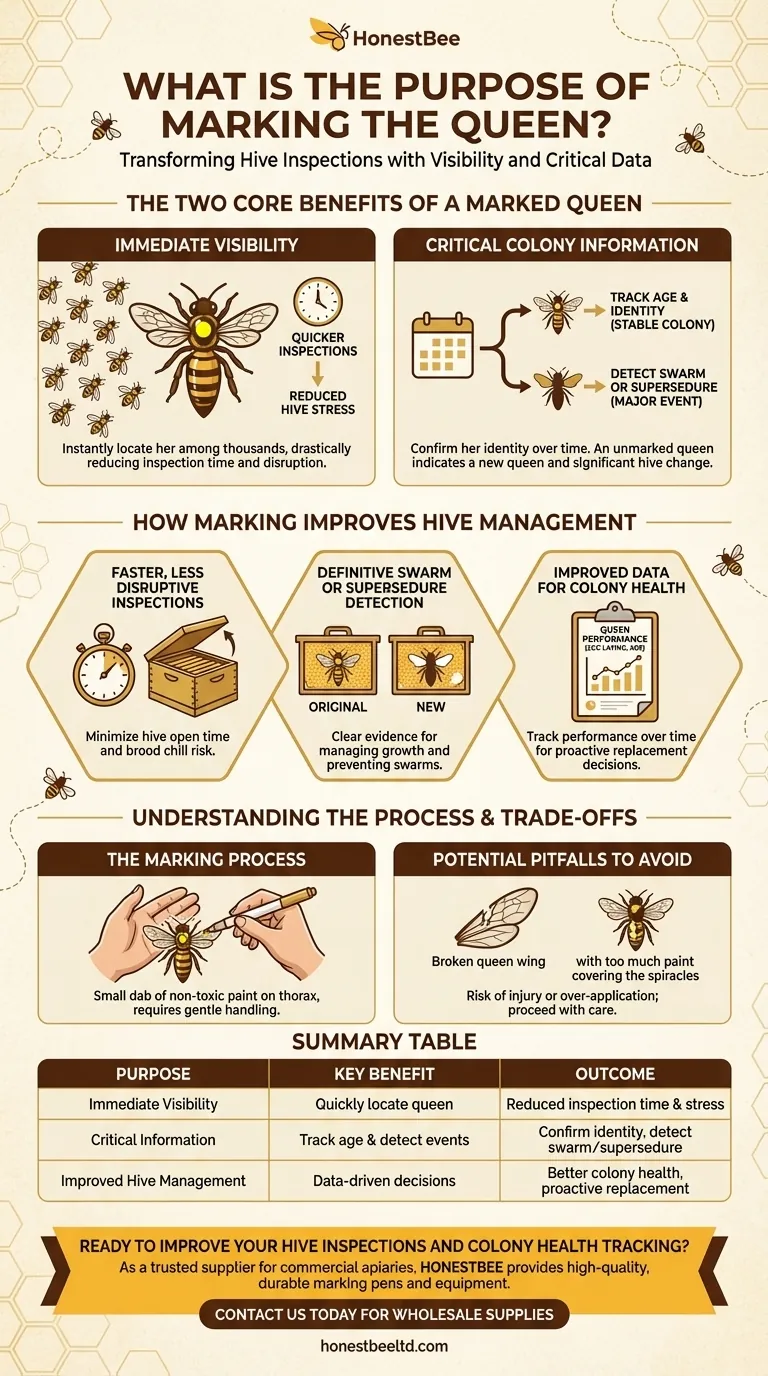The primary purpose of marking a queen bee is twofold: to make her instantly visible among thousands of worker bees and to provide crucial information about her age and the colony's history. This simple act transforms a time-consuming search into a quick, data-rich assessment of the hive's status.
Marking a queen isn't just about finding her faster; it's about turning her into a living data point. Her presence, absence, or replacement tells a definitive story about the colony's stability, health, and recent events like swarming.

The Two Core Benefits of a Marked Queen
At its heart, marking a queen solves two fundamental challenges for the beekeeper: finding the most important bee in the colony and understanding the colony's recent history at a glance.
Immediate Visibility
A healthy honey bee colony contains tens of thousands of bees. Finding one specific bee—the queen—can feel like an impossible task, especially for new beekeepers.
A small, brightly colored dot on her thorax makes her stand out immediately. This drastically reduces the time needed for hive inspections.
Critical Colony Information
The mark on a queen is more than a beacon; it's an identifier. It confirms that the queen you see today is the same one you saw last month.
If you find an unmarked queen in a hive that should have a marked one, you know a major event has occurred. The colony has either swarmed (your old queen left with a portion of the bees) or performed a supersedure (the bees replaced her themselves).
How Marking Improves Hive Management
Knowing the queen's status directly translates to more effective and confident beekeeping. It allows you to make informed decisions rather than guessing about the state of the hive.
Faster, Less Disruptive Inspections
The longer a hive is open, the more stress is placed on the colony. Quickly locating the queen to confirm she is present and laying well means you can close the hive sooner.
This minimizes disruption to the bees' work and reduces the risk of chilling the brood.
Definitive Swarm or Supersedure Detection
Without a marked queen, you can only suspect a swarm or supersedure has happened. With a marked queen, the evidence is clear.
Seeing a new, unmarked queen tells you definitively that the original queen is gone. This knowledge is critical for managing colony growth and preventing future swarms.
Improved Data for Colony Health
Marking provides a clear record. You know for certain how long a particular queen has been leading a colony.
This allows you to track her performance over time, evaluate her egg-laying pattern, and make a proactive decision to replace her if her productivity declines due to age.
Understanding the Trade-offs
While marking is overwhelmingly beneficial, it is a hands-on manipulation that requires care. The goal is to provide information with minimal risk.
The Marking Process
Marking is done by placing a small dab of specially designed, non-toxic paint on the top of the queen's thorax (the middle section of her body). This is often done using a dedicated marking pen or a fine brush.
Potential Pitfalls to Avoid
The primary risk is injuring the queen during the process. She must be handled gently and held for the briefest possible time.
Additionally, applying too much paint could cover her spiracles (breathing pores) or impede her movement. The paint can also wear off over time, which is itself a data point indicating the passage of time.
Making the Right Choice for Your Goal
Deciding to mark your queen depends on your beekeeping objectives.
- If your primary focus is efficiency: Marking is one of the single best things you can do to shorten inspection times and reduce colony stress.
- If your primary focus is data and health tracking: Marking is essential for definitively knowing when a swarm or supersedure has occurred and for tracking queen age.
- If you are a new beekeeper: Marking your queen builds confidence and makes the crucial task of "finding the queen" significantly easier to learn.
Ultimately, marking your queen empowers you with clear, unambiguous information, turning a simple hive inspection into a powerful diagnostic tool.
Summary Table:
| Purpose | Key Benefit |
|---|---|
| Immediate Visibility | Quickly locate the queen among thousands of worker bees, reducing inspection time and hive stress. |
| Critical Information | Track queen age, confirm identity, and definitively detect swarming or supersedure events. |
| Improved Hive Management | Make data-driven decisions on colony health, queen performance, and proactive replacement. |
Ready to improve your hive inspections and colony health tracking?
As a trusted supplier for commercial apiaries and beekeeping equipment distributors, HONESTBEE provides the high-quality, durable marking pens and equipment you need to manage your operations efficiently and effectively. Our wholesale-focused operations ensure you get the reliable tools required for precise queen marking and superior hive management.
Contact us today to discuss your supply needs and discover how our beekeeping solutions can support your success.
Visual Guide

Related Products
- Queen Bee Marking Pen UNI Medium Point for Queen and Bee Marking
- No Grafting Queen Rearing Kit: System for Royal Jelly Production and Queen Rearing
- Professional Engraved Round Hive Number Tags for Beekeeping
- Plastic Chinese Queen Grafting Tool for Bee Queen Rearing
- HONESTBEE Advanced Ergonomic Stainless Steel Hive Tool for Beekeeping
People Also Ask
- What is the purpose of a queen marking pen in beekeeping? Essential for Efficient Hive Management
- What are the color codes in the queen-marking system? Master Hive Management with the 5-Year Cycle
- What are the advantages of using Uni-Posca markers for Queen marking? A Safe, Precise, and Efficient Solution
- What are the benefits of marking queen bees? Boost Hive Health & Management Efficiency
- What are the characteristics of Posca pens for marking queens? A Safe, Durable Solution for Hive Management



















